
- Allohistorical Allusion: Italy led by the National Populist ANI (Legionnaire Italy) is furiously nationalist and militarist, and wants to centralize power (having ANI in power instantly shuts down any future elections), eliminate the socialists, remove foreign influence, and in the long run, possibly reclaim all Greater Italian lands and form an Italian Empire. Sounds similar to a real-life 20th century Italian state?
- Enemy Mine: Austria is an enemy to Italian nationalists, but the Republicans were forced to work with Austria in order to halt the Socialist Republic of Italy and prevent their own defeat. Similarly, while Austria can easily crush the Italian Republic, they find it useful to have it as a buffer against the Syndicalists.
- Full-Circle Revolution: Austrian pressure can force the Italian Republic to return to a monarchy, and can even crack down on Republicanism after that, effectively resetting all the efforts of the Republicans.
- Occupiers Out of Our Country: The Associazione Nazionalista Italiana (Italian Nationalist Association) is fiercely nationalist, revanchist, and anti-Austrian. They will sooner or later go to war with Austria to remove them from Italian lands.
- Puppet State: Austria puppets the Republican government in all but name; when the socialists are defeated, Austria might decide to backstab Italy by restoring the divided Italian states or force an Austrian king onto the Italian throne. However, there's also a fairly good chance that Austria will pull out of Italy early on, leaving the Republic relatively free of their influence.
Ivanoe Bonomi

- The Quisling: Bonomi is considered by some to be one due to his willingness to work with the Austrians.
Costanzo Ciano

- Allohistorical Allusion: Many of Legionnaire Italy's events and focuses are directly based on Fascist Italy:
- Upon coming to power, Ciano instantly ditches the Prime Minister title for "Il Duce".
- Instead of Blackshirts, Legionnaire Italy has Blueshirts, which is the exact same organization as the Blackshirts are in reality (Voluntary Militia for National Security
 ), just founded during the Italian Civil War. The blue shirts worn by the Blueshirts, like the black shirts worn by the Blackshirts, are based on the uniforms of the Arditi.
), just founded during the Italian Civil War. The blue shirts worn by the Blueshirts, like the black shirts worn by the Blackshirts, are based on the uniforms of the Arditi. - Some of the things that Ciano forms in Italy include Opera Nazionale Balilla
 youth organization, Opera Nazionale Dopolavoro
youth organization, Opera Nazionale Dopolavoro recreation organization, the Order of the Roman Eagle
recreation organization, the Order of the Roman Eagle award, and National Council of Corporations
award, and National Council of Corporations , all of which were created by Fascist Italy in real life.
, all of which were created by Fascist Italy in real life. - The OVRA
 Secret Police is created, though its name is changed from Anti-Fascism to Anti-Nationalism.
Secret Police is created, though its name is changed from Anti-Fascism to Anti-Nationalism. - One of the Italian State's focuses is called Four Economic Battles
 , based on economic policies taken by Fascist Italy in reality.
, based on economic policies taken by Fascist Italy in reality.
- The Coup: If he did not won the elections, Ciano may still come to power by marching with his Blueshirts on the capital of Milan.
- President for Life: After coming to power through a democratic election, Ciano stops elections and turns the Italian Republic into a far-right ultranationalist dictatorship.
- The Purge: One of the Italian State's focuses is "Purge Red Menace", which involves removing any civil servants with socialist connections from power. Another later called Purge Opposition completes its work by removing all opposition to the state.
- Putting on the Reich: The Italian State recreates many of the elements of Fascist Italy in Kaiserreich's timeline.
- Secret Police: The Italian State creates the OVRA to arrest any dissidents and ensure supremacy of the national populist government.
- Tyrant Takes the Helm: After being elected as the Prime Minister, Ciano shuts down democracy and ushers in a new age of radical ultranationalism.
- Video Game Cruelty Punishment: Veneto will always rebel if the ANI comes to power.
Gian Galeazzo Ciano

- Hereditary Republic: Gian Galeazzo Ciano will succeed his father Constanzo Ciano after his death.
Amedeo I

Umberto II

- Gilded Cage: King Umberto's every moves are watched.
- Irony: Umberto in OTL was the last king of Italy, after a referendum voted in favor of abolishing the monarchy after WWII. Here, the opposite happens after defeating the socialist-republican Italy.
- Puppet King: Umberto is essentially a puppet of the ANI.
- Rightful King Returns: Umberto II is the son and heir of Victor Emmanuel III, the king that abdicated as Italy collapsed.

- Occupiers Out of Our Country: Venice will revolt against Ciano after he comes to power to create an independent state (although it may also restore the Italian Federation).

- Allohistorical Allusion: While there hasn't been a Socialist Republic of Italy (RSI), there has been an Italian Social Republic
 (RSI). It was the puppet state led by Mussolini after the Nazis forcibly re-installed him. Mussolini's path include changing the country's name to Italian Social Republic and adopt the same flag as the OTL regime.
(RSI). It was the puppet state led by Mussolini after the Nazis forcibly re-installed him. Mussolini's path include changing the country's name to Italian Social Republic and adopt the same flag as the OTL regime. - Book Burning: During the Cultural Revolution, a large bonfire is lit in Florence, where people burn reactionary books and historical culture.
- Chummy Commies: Compared to Mussolini and his ilk, the Syndicalists and Radical Socialists are determined to defend socialist democracy to the last.
- The Gulag: Mussolini's SRI can establish work camps for enemies of the state.
- Illegal Religion: Mussolini's SRI will institute State Atheism, and churches are actively destroyed during the Cultural Revolution.
- Murder Is the Best Solution: During the Cultural Revolution, Mussolini's Ministry of Public Security will not prosecute revolutionary violence against reactionaries during the revolution, leading to a wave of violence across Italy.
Giuseppe Giulietti

- Cincinnatus: Should Mussolini fail to consolidate his power in time he will be removed and replaced by a returning Giulietti, who remains in power until he is replaced by a Syndicalist leader.
- Nice Job Breaking It, Hero: By forming a government with Mussolini and the fascists, Giuletti inadvertedly legitimised them as a movement, which, at worst, will result in the creation of a dictatorship by them.
- Warhawk: Giuletti is extremely militaristic, advocating for Italian entry into World War 1 and also advocated for an extremely militaristic stance on defending Syndicalist Italy's borders against Austria as a neccesity for Syndicalism to survive.
Benito Mussolini
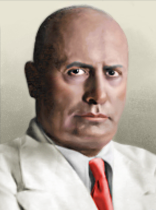
- Allohistorical Allusion:
- Mussolini can come to power in this timeline as he did in real life, although the situation surrounding his ascent to power is very different from the events leading to the emergence of Fascism in Europe in real life.
- If the SRI is defeated by Republican Italy, after reunification, Mussolini will be sentenced to death as a traitor in the Verona Trials. In reality, the Verona Trial
 is a trial by Fascist Italy against members of the Grand Council of Fascism who voted to remove Mussolini from power in 1943.
is a trial by Fascist Italy against members of the Grand Council of Fascism who voted to remove Mussolini from power in 1943. - Mussolini's path ends with him adopting the title of Duce and creating the PNF.
- Assassination Attempt: Mussolini will be shot by a woman after consolidating his rule, wether he dies or merely grazed is up to the player.
- Commie Nazis: Adheres to a much more left-leaning form of Fascism in contrast to OTL.
- Cult of Personality: Mussolini builds a huge cult of personality around himself as chairman, particuarly in the path where he reforms the party to his image.
- Gameplay and Story Segregation: Mussolini is represented as the leader of the Syndicalist ideology after Giulietti steps down despite being a Totalist to represent the power-sharing agreement he has with the Trade Unionists.
- The Political Officer: One of the focuses in Mussolini's SRI allows for the creation of Commissars to further his control.
- Run for the Border: If the Actionists come to power after the post-unification election, Mussolini will resign from his poistion and flee the country before they can impeach him.
- Secret Police: Mussolini creates the Ministry of Public Security to root out reactionaries and counterrevolutionaries.
- Significant Wardrobe Shift: Mussolini's portrait will change to one of him wearing a blackshirt uniform after his rule becomes secured.
- Tyrant Takes the Helm: Mussolini taking power will dismantle SRI's democracy and either concentrate power to himself or impose the principles of sansepolcro on the SRI.
- Warhawk: Like in real life, Mussolini is a huge militarist, and justifies his positions not only with nationalistic rhetoric, but also with the purpose of defence of the revolution. In the game itself, Mussolini has a "Warmonger" trait.
- Wicked Cultured: Mussolini and his faction are patrons of Futurism, like in real life.
Alceste De Ambris

- The Coup: If Togliatti succeeds Mussolini, De Ambris will attempt to overthrow him by leading the Blackshirts on a March on Rome.
Carlo Rosselli

- Allohistorical Allusion: Should he suceed in the constitutional restoration, the Workers' Republic shares the same flag as the OTL Giustizia e Libertà
 movement, which he co-founded with Ferruccio Parri and Sandro Pertini in his exile in Paris.
movement, which he co-founded with Ferruccio Parri and Sandro Pertini in his exile in Paris. - Assassination Attempt: If the focus ‘Break the Enemies of Democracy’ is not taken before Rosselli starts his constitutional reforms he will become victim of an assassination.
Emilio Lussu

- Military Coup: Lussu may come to power by the Veterans' Coup, leading veterans' associations supported by the Army to remove Mussolini from power.

- Allohistorical Allusion:
- Pope Pius XI issues the encyclical Quadragesimo quinto anno ("In the 45th Year") in 1936, an allusion to Quadragesimo anno
 Pius XI issued in 1931 in real life. The contents of the encyclical are identical, except that communism is replaced with syndicalism.
Pius XI issued in 1931 in real life. The contents of the encyclical are identical, except that communism is replaced with syndicalism. - All four potential successors to Pius XI also took part in the Conclave held for the real Pius XI's succession, with the historical winner being Eugenio Pacelli (Pius XII).
- Pope Pius XI issues the encyclical Quadragesimo quinto anno ("In the 45th Year") in 1936, an allusion to Quadragesimo anno
- Church Militant: The Papal State has a small army in the form of the Palatine Honour Guard, as well as a navy in 1936. They can develop an air force too and become a respectable force on Italy.
- Red Scare: Pius XII and Julius IV can issue an encyclical to condemn syndicalism through the focus "Condemn Mob Rule".
- The Theocracy: Rather obviously, the Catholic Pope is the absolute monarch of the Papal States. Under Stephen X or John XXIII it can be downplayed, as they can cede most temporal power to an elected assembly and associated secular institutions, but they still maintain their authority over the church and position as head of state over the Papal States.
Pius XI

- Plot-Triggering Death: Pius XI will inevitably die when Black Monday hits, leading to the election of a new Pope.
Pius XII
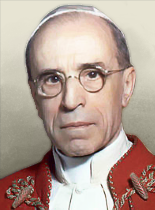
Eugenio Pacelli is the Archbishop of Sardes, papal name Pius XII. He is known for his traditionalism and wishes to maintain the order in Rome, his home city.
- Good Old Ways: Pius XII is a traditionalist, and wants to keep the Papal State safe and stable.
Stephen X
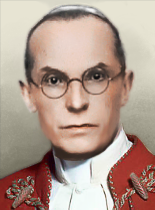
Elia dalla Costa is the Archbishop of Padua, papal name Stephen X. He is revered for his faith and respected for his humanitarian services during the Weltkrieg.
- Cincinnatus: Pope Stephen X can relinquish his civic powers and reform the Papal State into a constitutional monarchy, transforming power to the people of Rome.
- We Help the Helpless: Stephen X has several focuses where he helps out poor starving people and refugees.
John XXIII
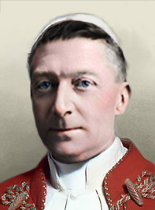
Achille Liénart is the the Archbishop of Lille, papal name John XXIII. He is a social reformer, and supports trade unionism and the Worker-Priest movement.
- Allohistorical Allusion: There was an actual OTL pope using this name; they're not the same person (OTL's John XXIII was an Italian prelate named Angelo Giuseppe Roncalli, who reigned from 1958 to 1963).
- Cincinnatus: Like Stephen X, John XXIII can cede his civil powers to the people of Rome.
- Historical Hero Upgrade: The real Liénart is a somewhat controversial figure thanks to his active support to Vichy France and his absence of opposition to Vichy's antisemitic policies. In Kaiserreich, he's a moderate socialist able to reform the Papal State without bloodshed.
- Internal Reformist: Liénart is politically a moderate socialist, and he can create Christian trade unions to reform the system without creating a revolution.
Julius IV
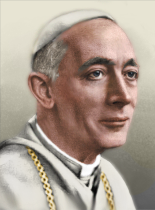
Alfredo Ildefonso Schuster is the Archbishop of Milan, papal name Julius IV. He is a stern militarist, and believes in an eleventh crusade against the threat of syndicalism.
- Warhawk: Julius IV is by far the most pro-war Pope, and can declare the Eleventh Crusade on the Syndicalists.
- Well-Intentioned Extremist: Julius IV has good intentions of trying to preserve Catholic order when it's under existential threat from the Syndicalists. However, he is very aggressive about it.

A pre-Risorgimento kingdom restored by Austria in the Treaty of Trieste as a part of the Italian Federation. It was restored on the mainland royalist-controlled areas in the Italian Civil War, the royalists having been forced into Austrian alignment due to internal disunity. The kingdom currently pursues independent external policies, having withdrew from the Federation in 1926 in reaction to Austria's cowardice against the socialists' military agitation.
- The Federation: If the Two Sicilies defeats all of their enemies on Italy, they can reform Italy into the Italian Confederation, a government so loose it is represented by the members of the Confederation being puppets.
Ferdinando III

- Rightful King Returns: Ferdinando III was the heir to the throne of the Two Sicilies, of which his family had been ousted during the Italian Unification but restored to by Austria-Hungary with the Treaty of Trieste after the end of the First Weltkrieg.
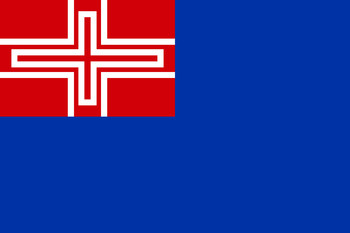
- Deadly Euphemism: One focus for Sardinia is "Disappear Our Rivals", in which the King approves for all members of the opposition to be given a "Mediterranean Cruise".
- Rightful King Returns: Their goal is to restore the rule of the Savoys to Italy as a whole, or at least Piedmont.
- The Starscream: If Germany takes over Piedmont, they have the option to offer it to Sardinia in exchange for them leaving the Entente and joining the Reichspakt, making them only one of two starting members of the Entente able to betray their allies without having their original government be overthrown beforehand (the other is National France). Needless to say, the rest of the Entente don't take kindly to this.
- Vestigial Empire: While true for the entirety of the starting members of the Entente, it is especially true for them. Sardinia is the sole remaining possession of the House of Savoia, who ruled Sardina-Piedmont and then Italy. While civil war engulfed the peninsula immediately after Italian capitulation, Savoia was able to establish a court here outside the reach of the Austrians and the Syndicalist rebels.
Amedeo I

The son of King Emanuele Filiberto who succeeded him after his death in 1931. He's the current head of the House of Savoy, and the current King of Sardinia-Piedmont.
- Praetorian Guard: Amedeo is guarded by a small set of troops that escorted him into exile. This guard can be expanded and enshrined within the Kingdom as the King's sworn protectors.
- Puppet King: King Amedeo is so aligned with National France that claiming him to be a puppet would not be out of place.









